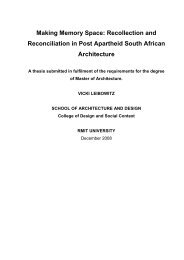Objects in Flux - RMIT Research Repository - RMIT University
Objects in Flux - RMIT Research Repository - RMIT University
Objects in Flux - RMIT Research Repository - RMIT University
Create successful ePaper yourself
Turn your PDF publications into a flip-book with our unique Google optimized e-Paper software.
<strong>Objects</strong> <strong>in</strong> <strong>Flux</strong><br />
[Figure 6-2]<br />
Ford Model-T automobile used to<br />
power a small saw mill.<br />
Photograph from the Collections of<br />
The Henry Ford.<br />
106<br />
6.2 Interpretative flexibility<br />
accounts, the highly contested nature of object<br />
use becomes apparent. The producer’s ability<br />
to structure consumer behavior, and the actions<br />
taken by consumers to escape this control,<br />
positions the object as a site of struggle and<br />
highlights a political dimension with<strong>in</strong> practices<br />
of consumption. The chapter concludes with an<br />
exam<strong>in</strong>ation of emerg<strong>in</strong>g consumer resistance<br />
and collective action that threatens the authority<br />
of established commercial <strong>in</strong>stitutions.<br />
It is clear from Kl<strong>in</strong>e and P<strong>in</strong>ch’s study that practices of modification<br />
were widespread amongst automobile owners, particularly farmers,<br />
at the beg<strong>in</strong>n<strong>in</strong>g of the 20th century. US census data from the 1920s<br />
<strong>in</strong>dicates that the automobile was far and away the most popular form<br />
of <strong>in</strong>animate power on the farm, and media reports of vehicle modifications<br />
date back to 1903 (Kl<strong>in</strong>e & P<strong>in</strong>ch, 1996). While farmers gave<br />
positive accounts of the modification process, automobile manufacturers<br />
were generally less enthusiastic. In a survey conducted by the Rural<br />
New Yorker <strong>in</strong> 1906, six out of seven auto manufacturers’ adamantly<br />
opposed the use of the automobile as a stationary power source,<br />
claim<strong>in</strong>g such practices could damage the car’s eng<strong>in</strong>e or differential<br />
gear (Kl<strong>in</strong>e & P<strong>in</strong>ch, 1996, p. 784). The Rural New Yorker aligned<br />
itself with the manufacturers position, advis<strong>in</strong>g farmers to purchase<br />
dedicated stationary eng<strong>in</strong>es (such as those regularly advertised <strong>in</strong> its<br />
pages). This stance was given further support through journal articles<br />
written by agricultural eng<strong>in</strong>eers who provided expert advice warn<strong>in</strong>g<br />
of the danger posed by homemade conversions. In 1919, however,<br />
when conversion kits designed to ‘safely’ harness power from the cars’<br />
crankshafts or rear axles became widely available, and widely advertised<br />
with<strong>in</strong> the journal, the Rural New Yorker changed its editorial<br />
stance and began recommend<strong>in</strong>g such kits (Kl<strong>in</strong>e & P<strong>in</strong>ch, 1996).<br />
While journals such as the Rural New Yorker publicly supported commercially<br />
available conversion kits, manufacturers of farm vehicles<br />
generally adopted a more critical position. Quoted <strong>in</strong> a 1918 edition of<br />
Tractor World, the advertis<strong>in</strong>g manager for the La Cross Tractor Com-
















